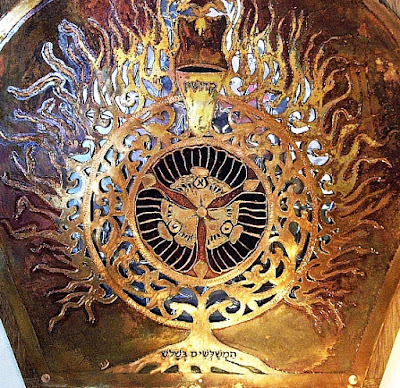Here are some thoughts to root to in times of chaos, trauma and transformation.
Shattering towards Wholeness
Shatteress“With shattering was the world created..”
Genesis 1:1
"Beraishit" using RESH SHIN SHIN as the 3-letter root
The letter cHET derives from the root cHET TAF TAF = terror, shatter, dismay
Each level of transformation begins from an initial point of “shocking the vessel” into a state of pulsation.
Excerpt from The Web of Life by Fritjof Capra:
Non-equilibrium: Tektology, the science of structure
“(Alexander Bogdanov) emphasizes in particular that the tension between
crisis and transformation is central to the formation of complex systems.”
crisis and transformation is central to the formation of complex systems.”
Page 191:
“A bifurcation point is a threshold of stability at which the dissipative structure may either break down or break through. At the bifurcation point, the dissipative structure … shows an extraordinary sensitivity to small fluctuations in its environment. A tiny, random fluctuation, often called 'noise,' can induce the choice of path.”
Cognition – The Process of Life
“(Gregory) Bateson thought that in order to describe nature accurately one should try to speak nature's language, which, he insisted, is a language of relationships. Relationships are the essence of the living world.”
The Hebrew letter tzadi is the 18th letter of the Alef-Bet - 18 representing "life." Tzadi means "hunt" as in "hunting for fallen sparks."
“Tzadik” refers to a person who walks in balance, having a mobile fulcrum which adjusts authentically to the demands of the moment. This balance evolves, not out of identity with virtue, but rather, through the integration of chaos. It is this redemptive processing of the murky, personal underworld which empowers tzadikim to raise the fallen sparks of consciousness to the benefit of all humanity.
“Tzadik” refers to a person who walks in balance, having a mobile fulcrum which adjusts authentically to the demands of the moment. This balance evolves, not out of identity with virtue, but rather, through the integration of chaos. It is this redemptive processing of the murky, personal underworld which empowers tzadikim to raise the fallen sparks of consciousness to the benefit of all humanity.
Akeidat Yitzhak 14:
“No one is wise in Torah but the master of traumatic experience.”
Wisdom is a function of becoming adept at integrating traumatic experience.
Nachson ben Aminadav was the guy who saw the Egyptians in hot pursuit of the fleeing Hebrew slaves and made the choice based on inner direction to “plunge” feet first into the Red Sea up to his nose – whereupon the sea parted. Nachson was a descendent of Judah and Tamar and the forebear of Boaz in the line-up to David - all players in the messy stories of shattering that, when internalize, symbolically lead us toward the unfolding of our own redemption.
Pashtus: Acting out of appropriate unreasonableness
Pashtus is the path of simple, direct and unsubstantiatable clarity.
It is for each person to perceive and follow their own pashtus, as it is entirely personized and precise. Pashtus requires you to listen and act upon the promptings of the internal voice of direction - the “Voice of the Silent Moment“– Kol Dimama Dakah.
The Rav (Tzvi Kahana) called this a dangerous path. Our minds contrive grandiose plans and desires to confound the Voice. The Powers-that-be are threatened when they have no jurisdiction over those who acknowledge the authority of their own choices.
Buckminster Fuller said in his Critical Path:
Buckminster Fuller said in his Critical Path:
“I am convinced that human continuance depends entirely upon: the intuitive wisdom of each and every individual . . the individual's integrity of speaking and acting only on the individual's own within-self-intuited and reasoned initiative . . . the individual's never joining action with others as motivated only by crowd-engendered-emotionalism, or a sense of the crowd's power to overwhelm, or in fear of holding to the course indicated by one's own intellectual convictions.”
Essentially, pashtus is the personal expression of Divine Authenticity within each moment.
Sounding the Shofar
Tekiah: “blast,” one long blast with a clear tone
Shevarim: “shattering,” sighing sound of three short calls
Teruah: “alarm,” a rapid series of nine or more very short notes
Tekiah Gedolah: “The Great Tekiah,” a single unbroken blast, held as long as possible
Other Notes:
If you'd be interesting in participating in a once-a-month online class via Skype let me know and I'll see about setting one up.
I'm participating in the annual Crestone Artists Open Studio Tour tthis weekend,October 8th and 9th from noon to 5pm both days. Would love to see you If you can make it. Here's the link for more info: http://www.crestoneartists.com/crestone-studio-tour-2016.html
With a call ahead of time, if I'm here, my studio is almost always open for a visit throughout the year.
L'Shana Tova!
I'm participating in the annual Crestone Artists Open Studio Tour tthis weekend,October 8th and 9th from noon to 5pm both days. Would love to see you If you can make it. Here's the link for more info: http://www.crestoneartists.com/crestone-studio-tour-2016.html
With a call ahead of time, if I'm here, my studio is almost always open for a visit throughout the year.
L'Shana Tova!

































